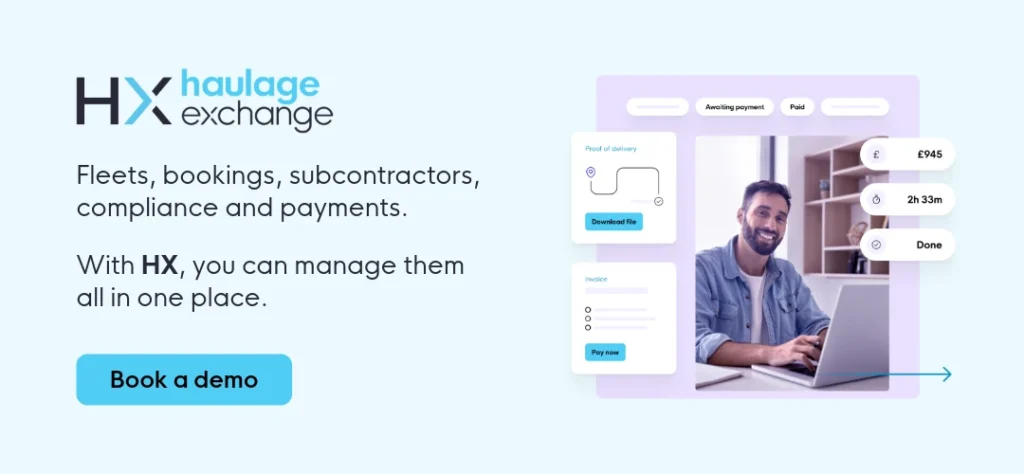Fuel is one of the biggest costs for any haulage company. Whether you run a handful of trucks or manage a large mixed fleet, fuel usage directly affects profitability. On top of this, clean air zones and decarbonisation targets mean that running an efficient fleet is no longer just a choice.
The good news is that fleet fuel efficiency can be achieved through a mix of simple checks, driver training, and technology-driven solutions. In this guide, we’ll look at both quick wins and longer-term strategies that can help you cut costs and reduce your carbon footprint.
What we’ll cover
Fleets, bookings, subcontractors, compliance & payments.
With HX, you can manage them all in one place.
Easy ways to cut your fleet’s fuel consumption
Not every change requires new vehicles or major investments. Small, consistent actions can reduce your fleet fuel consumption almost immediately.
1) Regular vehicle maintenance
Vehicles that are regularly serviced perform better and use less fuel. Under-inflated tyres, for example, increase rolling resistance and force engines to work harder. Fitting low rolling-resistance tyres and using tyre pressure monitoring systems (TPMS) adds further savings.
Routine servicing also prevents hidden fuel waste. Replacing clogged filters, old oil, or worn spark plugs ensures your fleet stays in peak condition. A proactive inspection schedule reduces your fleet’s fuel consumption while extending vehicle lifespan.
2) Driver training for fuel-efficient driving
Driver behaviour has a big impact on fleet fuel economy. Eco-driving courses help drivers adopt habits such as maintaining steady speeds, accelerating smoothly, and avoiding harsh braking.
Idling is another issue that drains fuel unnecessarily. Encourage drivers to switch off during long stops. Modern engines use less fuel restarting than idling for several minutes. You can also support drivers with telematics feedback, highlighting real-world behaviour improvements.
For fleets new to training, take a look at our guide on saving on HGV driver training.
3) Managing vehicle idling
Many HGVs and courier vans spend hours idling during loading, rest breaks, or traffic congestion. Across a fleet, this adds up to thousands of wasted litres each year.
Telematics systems allow you to monitor idle times in real time. Setting reduction targets and sharing results with drivers makes it easier to cut this waste and bring fleet fuel consumption down.

Advanced methods to improve fleet fuel efficiency
Once the basics are covered, advanced strategies can deliver even greater savings.
These often involve technology or operational changes that take more planning but bring long-term rewards.
Using telematics for smarter operations
Telematics is one of the most effective tools for increasing fleet fuel efficiency. It provides live insights into driving behaviour, fuel use, and vehicle performance. This allows you to act quickly, whether by addressing excessive speeding, reducing idling, or planning more efficient routes.
Modern systems now use AI-driven analytics to recommend real-time adjustments. Some even offer driver gamification features, rewarding those who achieve the best results.
Integrating telematics with carrier management software and TMS services allows fleet managers to coordinate more effectively, making every journey count.
You can also learn more about telematics integrations on Haulage Exchange.
Reducing empty miles with return loads
Empty return trips are a major source of wasted fuel. Every time a vehicle runs back to base empty, you’re paying for diesel without generating revenue.
The Haulage Exchange return loads freight exchange solves this by matching vehicles with available freight on the return leg. By filling backloads, you keep trucks productive, reduce empty miles, and cut diesel costs.
Our guide on reducing your fleet’s empty miles explains how this works in practice. The more loads you cover through HX, the stronger your fleet fuel economy becomes.
Upgrading to efficient and sustainable vehicles
New HGV models are designed with efficiency in mind. Features such as aerodynamic cab shapes, lighter materials, and more efficient engines can cut fuel bills straight away. Trailer skirts and cab deflectors also reduce drag, improving fuel usage on motorways.
For long-term planning, many fleets are now adopting sustainable alternatives. Sustainable fuels such as HVO (Hydrotreated Vegetable Oil) fuel, biogas, and hydrogen are gaining traction, especially for regional and long-haul operations. Electric trucks and electric courier vans are becoming a realistic option for urban routes as charging infrastructure expands.
If a full switch isn’t possible yet, upgrading to newer diesel engines still offers better fuel economy and lower emissions.
Gaining FORS accreditation is another way to show commitment to fuel efficiency and sustainability.
Looking ahead: sustainable fuels and compliance
Fuel efficiency measures also prepare fleets for future regulations. Many UK cities have expanded clean air zones, and the government has set ambitious targets for road freight decarbonisation.
By adopting alternative fuels, reducing idling, and cutting empty miles, you not only lower running costs but also ensure compliance with these rules. Platforms like HX give hauliers the tools to adapt now and remain competitive.
Conclusion
Improving fleet fuel efficiency doesn’t need to be complicated. Simple steps like servicing, driver training, and reducing idle time can cut fuel waste quickly.
For longer-term gains, investing in telematics, getting return loads on Haulage Exchange, and upgrading vehicles to more efficient or sustainable models will deliver strong results.
Whether you run vans, rigid trucks, or a large HGV fleet, these strategies will help reduce diesel use, strengthen compliance, and improve profitability.
Fleet fuel efficiency FAQs
What are the best ways to reduce fleet fuel consumption quickly?
Regular servicing, correct tyre pressures, and encouraging drivers to switch off engines during long stops are simple steps that reduce waste immediately.
How can telematics improve fleet fuel economy?
Telematics provides live data on fuel use and driving behaviour. This allows fleet managers to act on inefficiencies such as idling, speeding, or poor route planning.
Are electric HGVs practical for long-haul fleets?
Electric models are currently better suited for urban and regional routes due to charging availability. For long haul, alternatives like HVO and hydrogen are gaining ground.
What role do return loads play in reducing fleet fuel costs?
Return loads prevent empty journeys. Using HX to find backloads keeps vehicles productive, reduces empty miles, and cuts unnecessary fuel usage.
Which alternative fuels offer the best balance of cost and efficiency?
HVO is a strong option for fleets needing a drop-in replacement for diesel. Biogas and hydrogen are promising for long haul, while electric works best for local operations.




